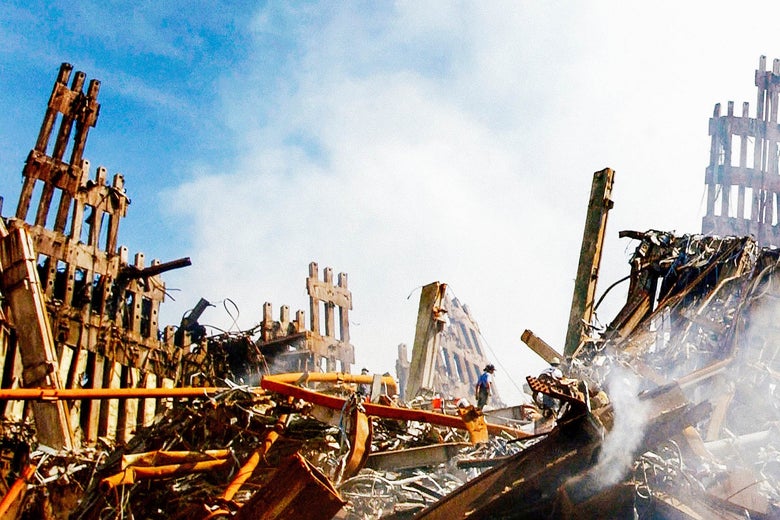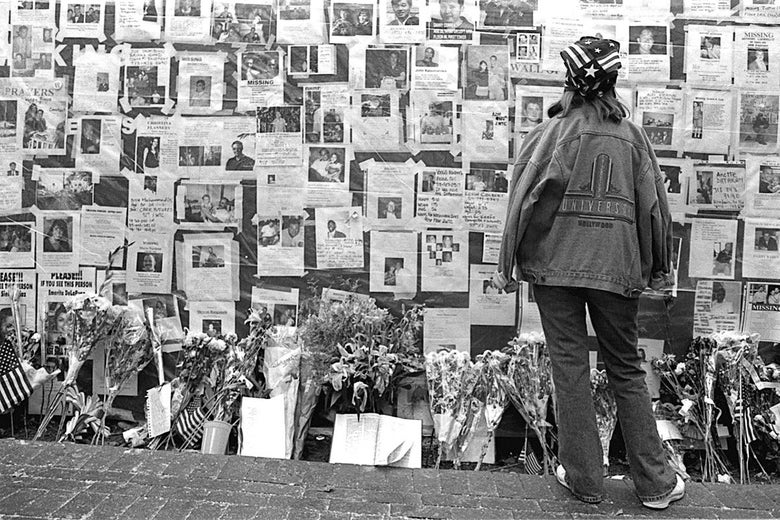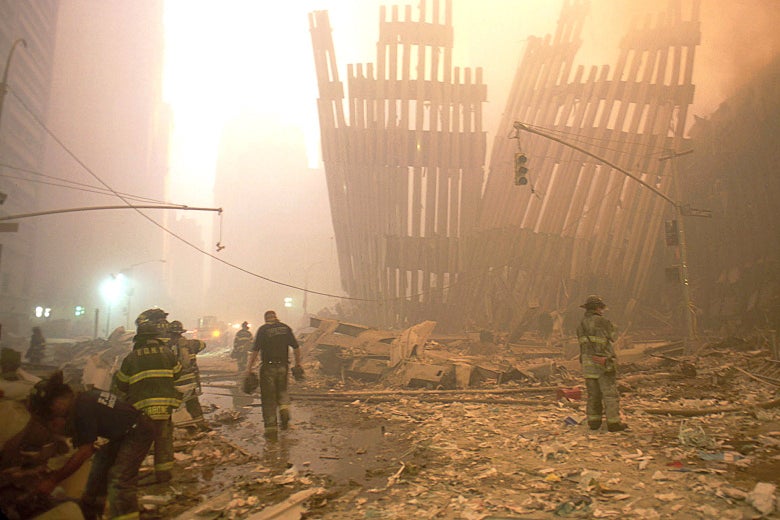FRED KAPLAN

On Sept. 11, 2001, I was in my seventh year as the Boston Globe’s New York bureau chief, spending much of my time writing fun features and profiles, a welcome respite after three years as the paper’s Moscow correspondent and, before that, a decade as its military affairs reporter. Those seven years were my own variation on the “holiday from history” that much of the nation was enjoying. At 8:50 a.m., my editor phoned, telling me that an airplane had crashed into one of the twin towers. I got dressed and turned on the TV in time to watch the second plane hit the other tower. This was no sightseeing pilot’s accident—my initial assumption—but a plot, an attack.
I dashed to the subway. On the ride from Brooklyn into Manhattan, I could see black smoke billowing from the buildings, streaking the clear blue sky like an oil spill. It looked like a Hollywood special effect. I arrived at the World Trade Center station, one of the last people to cross its turnstiles for many months to come, and ran up the steps. A large crowd had gathered to watch the towers burning. I found myself standing next to a reporter friend, and we wondered how long it would be before anyone would go back into those buildings.
Then, at 10 a.m., came the rumbling, which sounded and felt like an earthquake. The first tower began to collapse, and everyone ran, including me. Odd calculations raced through my mind: The tower was a little more than a quarter-mile high. I was a little less than a quarter-mile away. Should I run straight and hope to outrace the building’s fall, or should I dart down some side street to dodge its trajectory? It didn’t matter. I glanced back to see the tower crumble where it stood, like a sandcastle in the tide.
Everyone was in a state of horror. I talked with several people walking away from the disaster, some coated with ash. One man, a Xerox executive who worked a block from the towers, told me he’d seen “pieces of fuselage and body parts falling from the sky” and “strewn all over the street.” This was the first moment I realized that the weapons in the sky hadn’t been small prop engine planes, perhaps rented by saboteurs; they were passenger jetliners, hijacked by terrorists.
The subways were closed down. Cellular networks were mangled. I walked uptown toward the apartment of my Globe colleague Elizabeth Neuffer (a tenacious reporter who would die two years later in Iraq). The streets were empty and quiet, except for the sound of news broadcasts blaring from car radios and bars. At each one, and there were several on every block, dozens of people gathered around to hear the latest. Rumors were rife that planes had also attacked the Pentagon, the State Department, and the Capitol. (One of those reports was true.)
Over the next few days, the city was transformed. Popular depictions of New Yorkers as rude and rowdy had always been exaggerated, but the civility, courtesy, and mindfulness that washed over nearly everyone was astonishing.
It gradually became clear that the fresh breeze of unity—the notion that 9/11 brought us all together—did not extend to everyone.
I have a vivid memory of walking across Third Avenue at East 33rd Street three days after the attack. A man in front of me sneezed. A cop, who was guiding traffic at the intersection, looked him in the eye and said, “Bless you.” The pedestrian looked the cop in the eye and replied, “Thank you.”
That afternoon, a friend in Tribeca approached a police officer on the sidewalk and asked, “How are you?” (Many were asking strangers this question with genuine concern.) The officer broke down in tears.
To be a New Yorker in those days was to be stamped—proudly—with a special identity. One lunch hour, I wandered around Bryant Park, the small midtown cloister near the public library, to ask people if they were thinking about leaving the city. They all insisted that they were not. One young man with a Bronx accent replied, “What am I gonna do—move to Lincoln, Nebraska? That’s what the terrorists want me to do.”
All over the city, mimeographed sheets were taped or stapled on every available surface, especially subway station walls—photographs of the missing, with their names, their descriptions, and phone numbers to call if anyone saw them. People gathered to look at the photos, study them, read them carefully, as if they were memorizing their details. It was clear by this time that none of the missing would be found, not alive anyway. Yet people kept looking, out of respect—for the dead and for their loved ones who had posted the photos. The act was observed as a social obligation, a civic ritual: a moment of immersion into shared grief, a way to feel and affirm a sense of community and humanity that the attack had sundered but that its aftermath had strangely strengthened.

A young woman looks at one of the many displays with photos of the missing on Sep. 19, 2001, in New York City. Stephane Ruet/Sygma via Getty Images
For a while, anyway. It gradually became clear that the fresh breeze of unity—the notion that 9/11 brought us all together—did not extend to everyone.
Two months after 9/11, an airplane crashed in Far Rockaway, a beachside community in Queens. Everyone feared—or just assumed—that it was another terrorist attack. (It turned out to be “just” an airplane crash, the product of wake turbulence and pilot error as a passenger plane pulled up and away out of the nearby JFK International Airport.) I took the long subway ride to the crash site to interview authorities and witnesses. A Globe colleague who happened to be in New York rode with me. The reporter was of South Asian descent. Not long after we divvied up the territory, he approached me to say he was very uncomfortable with the way people were looking at him—as if he were a terrorist, as if he’d had something to do with the plane crash. He feared for his safety. (We agreed he should leave.)
Sometime before 9/11, I’d written a story about the soaring number of Pakistani immigrants in New York. They’d leased or bought wide swaths of business properties along Ocean Parkway in Brooklyn; the area’s councilman, also Pakistani, was emerging as a real political force. After 9/11, many of the neighborhood’s residents left town; many of the businesses shuttered; the politician, a charismatic community leader, lowered his profile.
President George W. Bush and Mayor Rudy Giuliani, to their credit, urged people not to take out their anger on American Muslims. But as more was learned about the attackers, and as we wreaked revenge on the attack’s planners, the feelings—and a broad emerging hawkishness—were hard to control.
“September 11 warped American culture,” Edward Luce, a Financial Times columnist, wrote in a recent reminiscence. “I had lived in the US until a few weeks before the attacks and returned five years later to a more paranoid, xenophobic and martial society.”
The attacks distracted everyone’s attention from other looming threats that may in the end do us more profound harm than that which was wrought by the terrorists.
Spencer Ackerman, in his new book, Reign of Terror, argues that “the 9/11 era destabilized America and produced Trump” (as the book’s subtitle puts it).
Donald Trump was hardly the first president to exploit the xenophobic streak in American culture, and 9/11 did not mark the first time a foreign attack sparked rampant fear of foreigners in the United States. (See, for instance, the Japanese internment camps during World War II.) But the spark this time was different; the threat was both more amorphous (a handful of hijackers with box knives) and more real (not even imperial Japan had attacked an American city)—and, as a result, more unnerving. The next attack could come anytime, anywhere, without notice; and the attacker wouldn’t be an army, navy, or air force; it might be that strange-looking man carrying a suspicious-looking object while walking down the street.
In that sense, al-Qaida turned America into a more skittish country; if the goal of terror is to terrorize, the 9/11 attacks were a success.
Within a few months, of course, U.S. forces fought back, toppling the Taliban, decimating al-Qaida’s ranks, and eventually killing bin Laden himself. But as recent events have shown, this triumph too was short-lived. In the 20-year interim, the nation—some of its leaders, nearly all of its legislators, and a majority of its citizens—took on an overly blunt view of “national security,” seeing myriad terrorist groups as a monolithic threat, when they weren’t monolithic (a shrewder strategy would have been to play some off the others) and most weren’t threats, not to our security anyway.
The 9/11 attacks provided the legal basis and the political selling point for several military adventures—not least the invasion of Iraq, the most serious foreign blunder in U.S. history. They also distracted everyone’s attention from other looming threats—strategic, political, economic, and especially ecological—that may in the end do us more profound harm than that which was wrought by the terrorists on two airplanes.
 Rescue crews engulfed in a fog of dust set about the task of finding survivors in the remains of the World Trade Center on Sep. 11, 2001. Mark Peterson/Corbis via Getty Images
Rescue crews engulfed in a fog of dust set about the task of finding survivors in the remains of the World Trade Center on Sep. 11, 2001. Mark Peterson/Corbis via Getty ImagesIn one sense, 9/11 may have been less pivotal geopolitically than 11/9—i.e., Nov. 9, 1989, the date when the Berlin Wall fell, which led to the unraveling of the Soviet Union and the end of the Cold War. The Cold War was a horrific era, but it was also a system of international security, and its end spawned not only the spread of democracy (in places, for a while) but also the dispersion of power, the crumbling of political blocs, the weakening of central authority in already-weak states, and the loosening of historically dubious borders. If the two superpowers had held a grip on their respective spheres of the world for another decade, it is likely that one of them, or both, would have crushed or at least contained an outfit like al-Qaida before it swelled in strength and ambition.
But 9/11 did mark a shift in our thinking about the world—about the likelihood, and randomness, of peril that it poses. The nature of this shift—and the degree of anxiety about the randomness—have been shaped and modulated by other political currents coursing through these long two decades. Even in the immediate aftermath of 9/11, at a time when America’s politics could still funnel disputes in relative calm and good order, the common new threat in our midst served as a unifying force only up to a point. Now that the elasticity of our politics has snapped, as myriad chasms—of race, party, class, and geography—seem increasingly unbridgeable, threats from outside (real or exaggerated) have intensified our disagreements, made consensus on even basic understandings harder to form.
Twenty years ago, citizens all over the country embraced New York in its hour of need and hung flags in a display of national unity. Would so many citizens do so today? Many among us have turned a pandemic—the classic case of a common threat from a faceless enemy—into a partisan battlefield. They’d likely respond in the same way to another terrorist attack.
Trumpism may have deepened this erosion of civil society. Yet the rise of Trumpism is, in part, a product of the 9/11 era. As Edward Luce put it in his FT reminiscence, “It is hard to imagine Donald Trump without Iraq, nor Iraq without September 11.” The compounding effects of these events and phenomena—the increasingly grating dissonances that they’ve etched on our collective consciousness—may be the most deeply consequential legacy of that day 20 years ago.
No comments:
Post a Comment